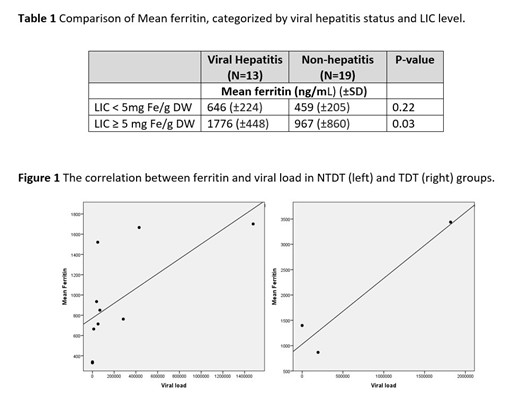Background: Serum ferritin is widely used as a marker of iron overload in thalassemia patients. However, the ferritin level is affected by active infections or inflammation. The association between viral hepatitis and serum ferritin level in thalassemia patients is still unclear. This study aimed to determine the effect of chronic viral hepatitis on serum ferritin level in thalassemia patients.
Methods: This was a cross-sectional study in thalassemia patients aged ≥15 years-old at Chiang Mai University hospital. We expected that thalassemic patients in our clinic have a mean serum ferritin of 767 ng/mL with a standard deviation of 210 ng/mL. As a result, we have to enroll a total of 28 patients to demonstrate 30% difference of mean serum ferritin when the power was set at 80% with alpha level of 0.05. Information on chronic viral hepatitis, mean serum ferritin and liver iron concentration (LIC) as measured by T2* MRI were collected. Chronic viral hepatitis status was confirmed by either HBV DNA or HCV RNA testing. Patients were categorized to hepatitis and non-hepatitis group. Serum ferritin levels were compared between two groups. LIC measurement was used as a gold standard for iron overload. Subgroup analysis was performed according to iron overload and transfusion requirement status. Categorical and continuous variables were compared using the Chi-squared test and T-test, respectively. The correlation between viral loads and mean serum ferritin levels was analyzed by Pearson's correlation.
Result: Of 32 thalassemia patients (25 non-transfusion dependent [NTDT] and 7 transfusion dependents [TDT]), 13 patients had chronic viral hepatitis (7 with hepatitis B and 6 with hepatitis C infections). The LIC between hepatitis and non-hepatitis groups were not significantly different (7.28 [SD 4.7] vs 9.08 [SD 5.2] mg Fe/g, p=0.19). In the higher LIC group (≥ 5 mg Fe/g), the mean serum ferritin level was higher in the hepatitis group than non-hepatitis group (1,776 [SD 488] vs 967 [SD 860] ng/mL, p=0.03). For the lower LIC group (<5 mg Fe/g), the mean ferritin levels were not significantly different between the hepatitis and non-hepatitis groups (646 [SD 224] vs 459 [SD 205] ng/mL, p=0.22). The correlation between the viral load and mean ferritin level in NTDT group showed a significant linear correlation with R=0.7 (p=0.04).
Conclusions: We observe a higher serum ferritin level among thalassemia patients who concurrently have chronic viral hepatitis. Chronic viral hepatitis is a possible cause of a falsely high ferritin level in these patient population. Furthermore, the viral load is positively correlated with serum ferritin level.
No relevant conflicts of interest to declare.
Author notes
Asterisk with author names denotes non-ASH members.


This feature is available to Subscribers Only
Sign In or Create an Account Close Modal